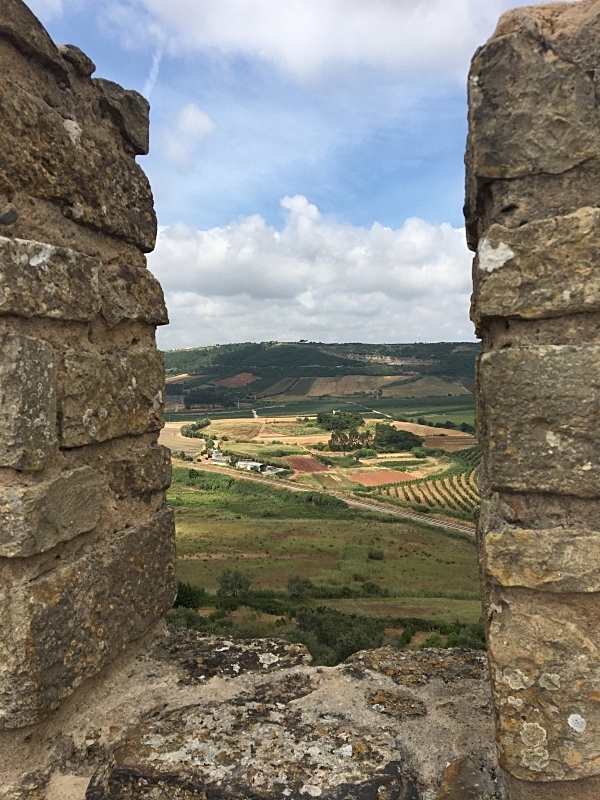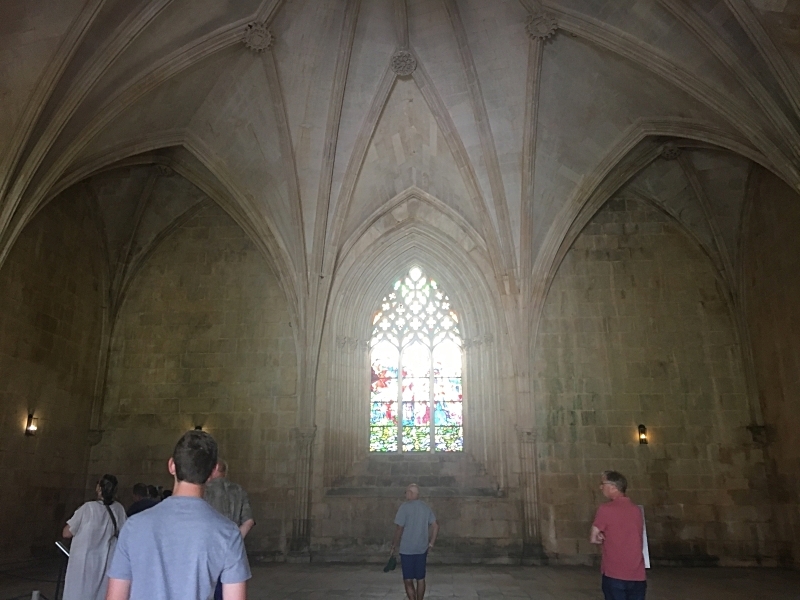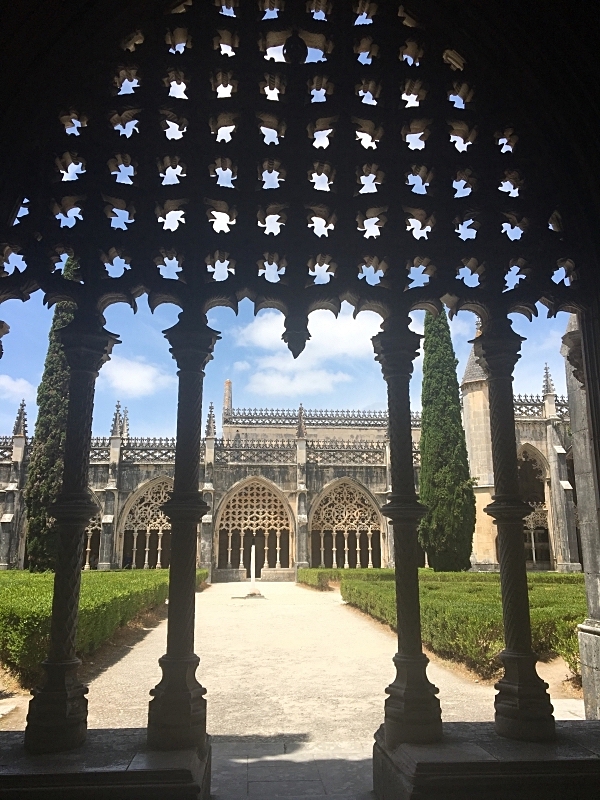Highlights of Portugal's Northern Region
The drive from Lisbon to Porto is very beautiful. Driving straight through takes about 2 1/2 hours. We decided to make our trip a leisurely drive stopping at some of the highlights of Northern Portugal. We were not disappointed. Having a private car and driver was essential. Carlos, our driver, was friendly and full of interesting facts and information regarding all of our stops. The smaller towns, the churches, the architecture and the art were astounding. It was a long day for us but each stop was unique. We left Lisbon around 9:00 am arriving at our first stop an hour later in the charming, medieval town of Óbidos.
Óbidos is a small, white washed, medieval town. The name, Óbidos, means “citadel” or “fortified city,” perfectly suited for this walled town. Óbidos has a long history dating back to the ancient Romans. During the 700s, the Moors conquered the area. In 1148, King Alfonso Henriques reclaimed the city in the final stage of his campaign to reclaim all of Portugal from the Moors. In 1210, King Alfonso II gave the village as a gift to his wife, Queen Urraca. As a result, the town was patronized by every Queen of Portugal. It was given the nickname, Vila das Rainhas or town of Queens. Óbidos also played a role in recent history when it served as the center of government and hosted meetings for the organizers of the 1974 Carnation Revolution. Today, Óbidos keeps its medieval history alive with a recreation of a medieval market for two weeks in July.
Óbidos Main Gate Door
Visiting the town is like stepping back into time. It’s a bit touristy but still retains its medieval charm. We spent about an hour exploring. The Porta de Vila is one of the most magnificent entrances to a town. This main gate was designed with two staggered entrances to prevent a direct attack from invaders. The gate also contains a gorgeous tiled chapel. The 18th century tiles on the walls depict the story of the Passion of Christ. The ceiling was painted to represent Christ’s crown of thorns. The chapel is stunning. When we walked through it, a musician was playing guitar; the acoustics were incredible.
Óbidos Chapel at the Main Gate
Chapel Ceiling of Thorns
After exiting the Porta de Vila, we strolled up the Rula Direita, the main street which is filled with shops and cafes. We also passed stalls selling Ginja de Óbidos. This cherry liquor served in small chocolate cups is a specialty of the town. Super sweet but a MUST to try! Halfway up the street, we paused to enter The Santa Maria Church which originated in the 12th century during the Christian conquest of the area by King Alfonso Henriques. It was built on the site of a mosque. In 1535, the original church was destroyed but rebuilt. The Church is famous for the wedding of King Alfonso V to his cousin, Isabel, in 1444. Alfonso was 10 years old; Isabel was 8!
Santa Maria Church
Interior of Santa Maria Church
The Narrow, Steep Wall Path
Our last stop in Óbidos was the town walls. The entire town is surrounded by the medieval walls that protected it from invaders. We decided to brave one part of the wall and ascended a steep set of stairs. The views are stunning from the top! The walls are definitely not for the faint at heart. The stairs and walkways are very narrow, steep and uneven. But even more scary- they have no railings. My kids walked easily along but I had one hand plastered to the wall as I walked. It takes about an hour to walk the entire perimeter. We did a tiny portion but felt very accomplished. I can’t imagine a knight trying to run up the stairs in full armor! After descending from the wall, we made our way back to the car to begin our 45-minute drive to our next stop, The Batalha Monastery.
View of Countryside from the Wall
View of Óbidos from the Wall
This was my most favorite spot I visited in all of Portugal. The Batalha Monastery is beyond breathtaking and awe inspiring. I felt a very deep feeling of peace walking around the different areas of this gorgeous UNESCO site. Batalha Monastery means “The Monastery of the Battle.” The official name is actually the Monastery of Saint Mary of the Victory. The Dominican monastery was commissioned by King Joao I to commemorate the victory of the Portuguese over the Castilians at the Battle of Aljubarrota in 1385. The monastery was a thank you to the Virgin Mary for this victory. The complex was the main project of the monarchy for two centuries from 1386-1517 and spanned the reigns of 7 kings. Many different workshops flourished during the building process. It is believed to be the first-place stained glass was used in Portugal. This Portuguese National monument is considered a masterpiece of the Gothic style although it also displays characteristics of the Manueline style.
King Joao I was responsible for a large part of the work including the church (1416), the royal cloister, the chapter house and the Founder’s Chapel. This became the funeral chamber of the 15th century Aziz Dynasty of Portugal’s Royalty. Alfonso Domingues, the 1st architect, designed the church and royal cloister. From 1402-1438, the architect Huguet took over and designed the façade, dome of the chapter house and Founder’s Chapel. He died before finishing the Imperfect Chapels. Construction ended in 1532 under the reign of King Alfonso V when he began construction on Jeronimos Monastery in Lisbon. In 1840, King Ferdinand II began restoring Batalha and in 1980 it became a museum.
I was blown away by the entire place. We were greeted in the square by an oversized statue of General Nuno Álvares Pereira (the leader of the forces during the reconquest). The statue sits in front of the limestone building; the stone has turned a yellow ochre with age. The façade is modeled a bit off of York Minster in England. 78 statues of Old Testament kings, angels, prophets and saints line the façade while Christ enthroned flanked by the four Evangelists appears at the top. I honestly didn’t know where to look first. I fell in love with the outside but was equally enamored with the inside!
The church with its narrow nave is beautiful. But the buildings attached to the church are equally amazing. The Founder’s Chapel (located immediately to the right when you enter) is a peaceful, beautiful space. The octagonal room is the first pantheon in Portugal and exhibits both Gothic and English characteristics. Located in the center of the room is a large tomb with two enormous sculptures on top. This is the tomb of King John I and Philippa of Lancaster. Their sculptures show the monarchs in full regalia and hands clasped indicating Portugal and England’s close relationship. Four of King John’s younger sons and their wives are buried here as well. After touring the Founder’s Chapel, we made our way to the front left side of the church’s nave. This is the entrance to the other buildings. The Chapter House, located off the Royal Cloister, has the Tomb of 2 unknown WWI soldiers. We were lucky to witness the solemn changing of the guard ceremony. Walking through the Royal Cloister is an experience. The quiet center garden produces a very peaceful feeling. The garden is surrounded by beautiful tracery and intricate stone screens. The cross of the Order of Christ is placed in many of the screens. I loved the Royal Cloister. From here we walked through a secondary cloister which had the most beautiful roses in bloom.
This walk led us out to the back of the Monastery where the entrance to the Imperfect Chapels stands. Despite not being finished these chapels are incredible. The octagonal structures were begun in 1437. The original design was Gothic but wasn’t finished. Years later, King Manuel I tried to finish the chapels. His influence is evident from the Manueline characteristics added to the Chapel- the decorative flowers, scrolls, and large motto, Leauté Faray Tom Yaserei (I will always be loyal), etched into the stone. It is believed that this refers to the only Monarch buried in the chapels, King Edward of Portugal and Eleanor of Aragon. King Manuel died before he could complete the project. Walking through the chapels with no roof, its high walls, empty sculptural niches, and moss covered stone is very emotional. It is easy to envision how splendid and grand the chapels would have been but sad to see the state they are in. After exiting the chapels, we decided to leave Batalha and began the short half hour drive to our next stop, Fátima.
Our driver was pleasantly surprised we wanted to visit Fátima since it’s not as popular with all tourist. But it is one of the most popular Catholic pilgrimage sites today. We were intrigued to see this holy location. Driving into the town is a bit touristy and noisy. But walking into the Cova da Iria (the courtyard where all of the shrines are located) I was struck by the quiet, peacefulness of the area which was once a large open field. It was in this field under a great oak tree that it is believed that Our Lady of Fátima appeared to three shepherd children.
In 1917, it is believed that the Virgin Mary appeared a total of six times to Lúcia Santos and her two cousins, Jacinta and Francisco Marto. The visions occurred between May and October. The children described the apparition as “a lady more brilliant than the sun” wearing a white cloak trimmed with gold and holding rosary beads. She has also been called “The Angel of Peace and of Portugal.” She gave the children three secrets. The first was a vision of hell and the importance of prayers, the rosary and sacrifice as a way of adoration to the Lord. She also told the children that 2 of them would die soon while Lúcia would live and spread the message of devotion to the Immaculate Heart of Mary. The second message revealed that prayer would put an end to the Great War (WWI) and devotion to the Immaculate Heart of Mary would save souls and ensure peace. She also asked for the consecration of Russia and if this didn’t happen a worse war would occur.
The final vision occurred on October 13, 1917. 60,000 people joined the children to witness it. The event has been nicknamed “The Miracle of the Sun.” People described seeing radiant colors dancing from the sun. Some people saw nothing. Lúcia said the final secret wasn’t to be revealed until 1960. It was eventually revealed by the church in 2000. This vision discussed the death of a Pope and other religious figures. Many believe it alludes to the assignation attempt on Pope John Paul II. A year later in 1918, both Jacinta and Francisco died from the Spanish Flu epidemic. Lúcia became a nun and continued to see visions her entire life. She lived to be 97 years old dying in February, 2005.
When we enter the Cova da Iria, we saw many people on their knees crawling on a path toward the Chapel of Apparitions. This is how a pilgrim ends their pilgrimage to the site. This small chapel is located right next to the great oak tree where the Virgin first appeared. To witness this type of devotion is truly moving. On one end of the courtyard is the Sanctuary of Our Lady of Fátima, a beautiful, large church decorated in white and very simple inside. The peaceful, contemplative atmosphere continues here. On the opposite side of the courtyard is the Basilica of the Holy Trinity. The Basilica is very modern and can hold thousands of people. No matter your religion, walking around this pilgrimage site is a truly moving experience.
After Óbidos, Batalha, and Fátima, we were pretty tired but Carlos insisted we make one more stop before arriving in Porto. So, we headed to Coimbra (about a 45-minute drive from Fátima). We were so glad that we did! Coimbra is the third largest urban center in Portugal after Lisbon and Porto. This riverfront medieval town is the former capital of Portugal. Within the city is the University of Coimbra, one of the oldest academic institutions in the world. The University was found in 1290 by King Dinis in Lisbon but moved to Coimbra in 1537 by King Joao III. The University is housed in a former royal palace. Our destination was the Biblioteca Joanina, a Baroque library founded by King John V in the 18th century.
The library was known as Casa da Livaria. It houses a total of 200,000 books; It received its first books in 1750. The main floor, or Noble floor, is divided by arches into three sections. This floor holds 40,000 books. The walls are covered with shelves two stories high made of thick, gilded and painted wood. Thick wood was used to keep the temperature and humidity low. To aid in this, two colonies of bats have lived in the library since its creation. The bats eat the insects to help protect the books even today. There are two floors below. The intermediate floor was the book depository and where professors and librarians worked. The bottom floor was used as the Academic Prison from 1559 to about 1773. The University had its own legal code as well as a Royal Academic Guard in the 14th century. After 1773, the floor became another depository for books. Today, it is the only medieval cell still in existence in Portugal. We walked in it- talk about a small space.
After a quick tour of the library, we were tired! Carlos, was a fabulous guide and drove us from Coimbra to Porto in about an hour. It was definitely a long day; we didn’t arrive at our hotel until about 8:00. But we loved everything we visited so it was worth it. I LOVED Batalha which was the highlight of the entire trip for me! Visiting each of these sites deepened our love of Portugal and its rich history.



























